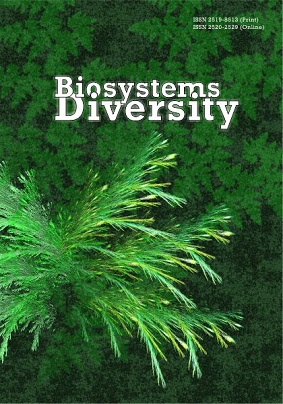Population analysis of Asarum europaeum in the Northeast of Ukraine
Population analysis of Asarum europaeum in the Northeast of Ukraine
Author(s): K. H. Hozhenko, H. Klymenko, I. N. KovalenkoSubject(s): Energy and Environmental Studies, Regional Geography, Environmental Geography, Sociobiology
Published by: Дніпропетровський національний університет імені Олеся Гончара
Keywords: population analysis; vital structure; ontogenetic structure; growth parameters;
Summary/Abstract: An analysis of the populations of Asarum europaeum L. in forest ecosystems of the North East of Ukraine during the growing periods of 2004–2015 was carried out. In carrying out field research we used standard methods of ecology, geobotany such as study plots of 400 m2 , and for detailed elaboration of the surface layer we used study plots of 100 m2. According to the results of the examination of plots of the size 50 x 50 cm, we obtained data on the number and density of individuals within populations. We found that populations of this species often dominate in the lower tiers of broadleaf and mixed forests in the region under research. We identified the basic population characteristics of the species and described its growth and development in three subformations: Querceta roboris, Pineta sylvestris, Acereto (platanoiditis) – Querceta (roboris). It was found that according to the time gradient, depending on meteorological conditions, the projective cover and the average population density of the plants vary. Based on the average growth rate of the plants, the balance of morphogenesis in the course of the plants’ ontogenesis was determined. We determined that the most optimal conditions for the growth and development of A. europaeum are provided in the North East of Ukraine in the subformation of Querceta roboris. The results of the analysis of ontogenetic state of partial bushes in populations of A. europaeum are described. It was found that populations in the subformation Querceta roboris and Pineta sylvestris were full-membered, while in the subformation Acereto (platanoiditis) – Querceta (roboris) it was unfully-membered with fallout of seedlings and juvenile plants. It was found that the population of A. europaeum in the Pineta sylvestris subformation, is left sided, with the peak number in pregenerative partial bushes – this was the youngest population with the highest Index innovation value and the lowest Index senilis value. The Index aetas of the youngest population is 0.14 while the Index generative is 45.0%. The population of A. europaeum in the subformation of Querceta roboris was more mature: Index aetas is equal to 0.19, the age range of the left-hand side with the peak on the partial bushes g1, Index generative reaches 55.4%. In the population with the subformation Acereto (platanoiditis) – Querceta (roboris) Index aetas is significantly greater than one and equals 2.35. In the oldest population, the age spectrum is centered with the peak on generative partial bushes, the Index generative is high and equals 68.5%. This vital analysis of the population structure is based on a sample of more than 3,000 partial shrubs. The key signs of vitality were: total phytomass (W), leaf surface (A) and reproductive effort (RE1). It has been established that two of the three populations studied A. europaeum are in equilibrium (from the subformations of Pineta sylvestris and Acereto (platanoiditis) – Querceta (roboris)) and one is flourishing.
Journal: Biosystems Diversity
- Issue Year: 25/2017
- Issue No: 3
- Page Range: 210-215
- Page Count: 6
- Language: English

